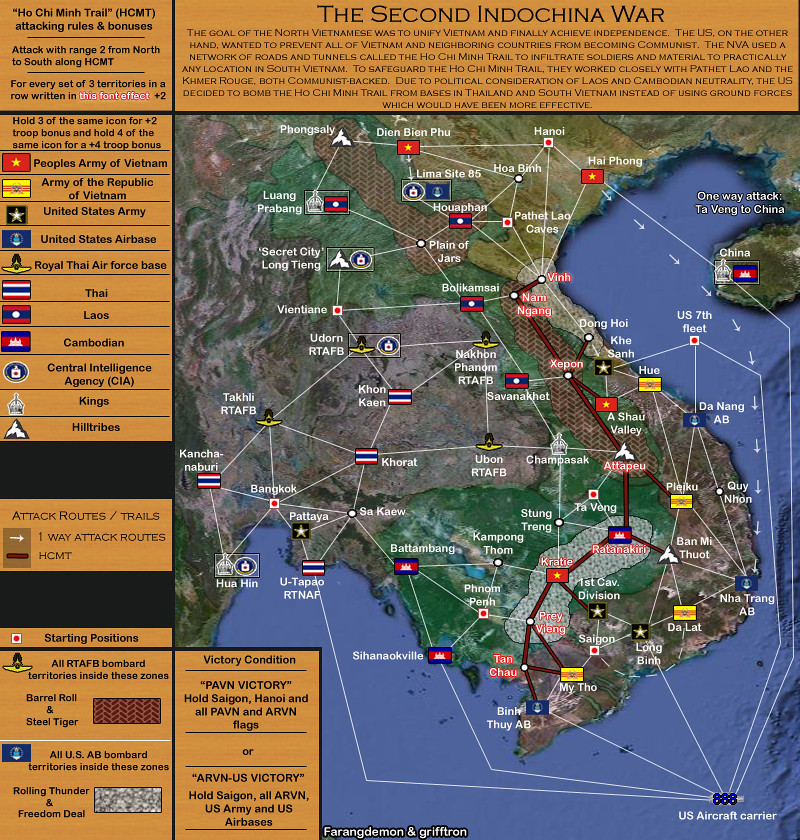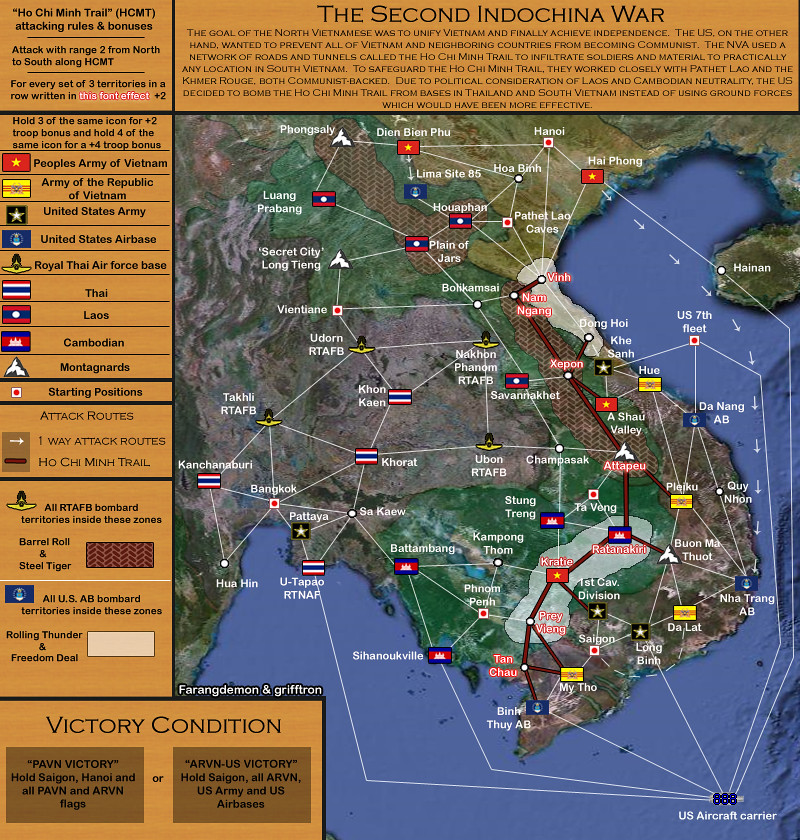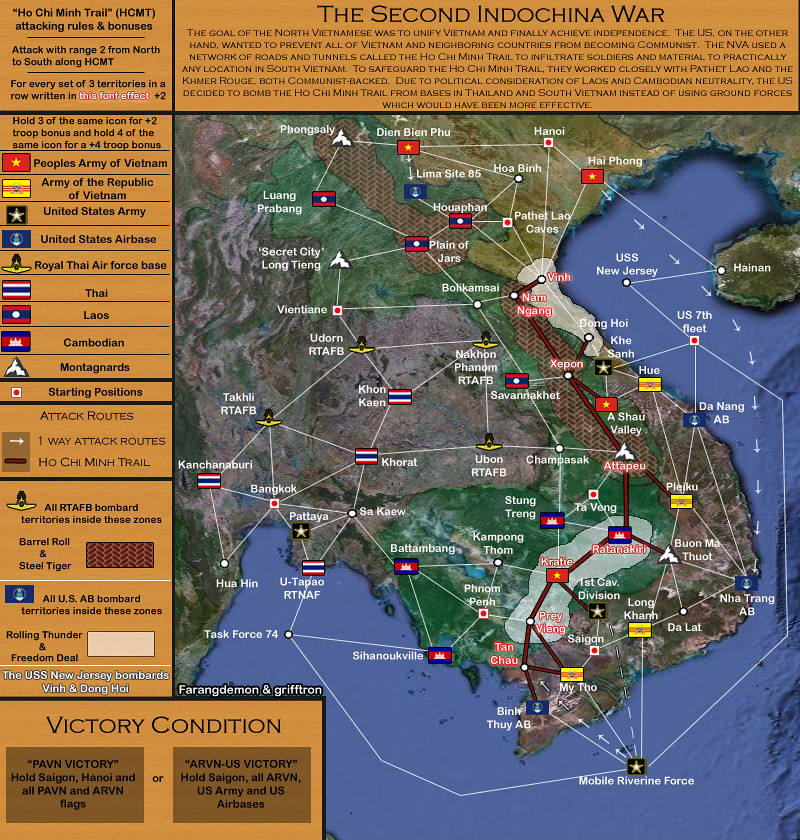Industrial Helix wrote:Well, i looked at Ardennes and I would venture to say that it might have been a mistake to pass that one as well. So saying its no more complicated than Ardennes isn't giving you much help.
I didn't say it was no more complicated than Ardennes. I said it is less complicated. My implication was that it is easy enough to understand and visualize even if Ardennes should never have been permitted.
Industrial Helix wrote:A map on the Indochina war needs to playout over the course of the game like the war itself did. Looking at this map, I can not for the life of me decipher how its going to play out. Yes, it has all the features in the right and historical places but that does not necessarily mean the game will play out anything like the Vietnam War.
Please consider the following features of this map that ensure that it plays out according to the realities of the Second Indochina War.
- The Ho Chi Minh Trail facilitated rapid attacks into South Vietnam and eastern Laos and Cambodia. Most of South Vietnam was not under effective control of the Republic of South Vietnam because of the porous nature of the Ho Chi Minh Trail. Even if some routes were stopped, men and material found their way southward. This is represented in our map by allowing attacks to range 2 going from North to South along the Ho Chi Minh Trail.
- Extensive bombing of Laos and Cambodia which killed many hill tribesmen, Laotians and Cambodians, in an effort to halt the flow of material down the Ho Chi Minh Trail.
- US forces cannot invade North Vietnam for political reasons.
- Ships from North Vietnam can attack South Vietnam (Hai Phong to Nha Trang). This represents infiltration of men and material from north to south. While they patrolled the waters, the US cannot attack Hai Phong because of political consideration to not invade North Vietnam.
- US Army at Khe Sanh cannot attack into North Vietnam for same political considerations.
- The Cambodian Incurison. 101st Airborne Division is allowed to violate Cambodian neutrality by attacking PAVN bases in Kratie. Destruction of this base means PAVN player has less resources (as it's part of the PAVN bonus) with which to harass the South and cannot launch further attacks from that particular region until it is retaken.
- The Battle (and subsequent fall) of Lima Site 85. The Battle of Lima Site 85 was a battle of the Vietnam War which resulted in the largest single ground combat loss of United States Air Force (USAF) personnel in that war. In August 1966, to assist ongoing aerial operations against the DRV (Operation Rolling Thunder), the United States Air Force sited a TACAN facility on the peak of Phu Pha Thi to assist American aviators conducting bombing operations. While General Vang Pao's Hmong army tried to delay the inevitable, the base was overran by PAVN forces and the US personnel were shot and their bodies thrown off a cliff - this is represented by the 1-way attack from Dien Bien Phu.
- Strategic Importance of Plain of Jars.
"During the Second Indochina War Xiangkhoang was the scene of extensive ground battles and intense aerial bombardment due to its strategic importance. The provinces of Houaphan and Xiangkhoang had been the stronghold of Pathet Lao forces and their Vietnamese allies. The heavy aerial carpet bombardments to neutralize those forces or to drop off unused ordnances after returning from missions in Vietnam turned the Plain of Jars quite literally into the Plain of Scars and the most heavily bombarded areas per capita worldwide. In addition to bombs massive quantities of defoliants and herbicides were dropped." - http://en.wikipedia.org/wiki/Phonsavan
We represent this by including it as a target of Barrel Roll and making it a bottleneck that must be fought over to gain Laos bonus. - King Norodom Sihanouk joins the Khmer Rouge. After Lon Nol's coup d'etat, Cambodian King Norodom Sihanouk fled to China. He then decided to join forces with the Khmer Rouge, whom he had always been accused by the US and Cambodian generals as being too soft on. The support of King Norodom Sihanouk was instrumental in winning the hearts and minds of the people to the cause of the Khmer Rouge - many believed they were fighting to reinstate their beloved King.
We represent this in our map by giving a one-way attack from the Khmer Rouge base, Ta Veng, to a spot in China that conveniently fits on our map, representing King Norodom Sihanouk. The Phnom Penh player, representing Lon Nol's regime, can still capture Sihanouk but has to go through more two additional territories first. So it is more likely that the Khmer Rough player will end up controlling him.
Industrial Helix wrote:So, for example, this is what I need to know: I need it explained to me how a player with the starting point at Bangkok is going to rationally play the game and how close is that going to be to Thailand's role in the Vietnam War?
If I were to break it down myself, I'd say with a starting positon at Bangkok I've got some strange options... I can capture the king of Thailand but I see no point because I would need to have the king of Laos and Cambodia to ever receive a bonus.
Depends on the drop whether or not you have the other kings already.
Industrial Helix wrote:What's the logic in having a trio of kings?
Simplification to make the game easy to play. You probably knew that.
Industrial Helix wrote:Perhaps the kings should enhance their own nations rather then need to be grouped with a foreign monarch, something like a King with its army is worth x amount.
That's a good idea and we have the following effects already - King Norodom Sihanouk (China) helps to gain Cambodian bonus because the region also counts as a Cambodian symbol. Likewise having the King of Luang Prabang helps to gain Laos bonus as Luang Prabang was one of the two most important cities of Laos. We would prefer to not add further complexity.
Industrial Helix wrote:So the best course of action is to capture the flags and get that bonus, everything else in Thailand is a waste of time.
Depending on the drop it may be beneficial for you to acquire some of the other symbols in Thailand. After consolidating the Thai flags, the next lowest hanging bonus fruit are the Royal Thai Airforce bases.
Industrial Helix wrote:The Thai airforce appears to be useless unless you want to use the territory as a choke point or something...
The Royal Thai Airforce bases yield the same bonus as all other symbol groups. The Royal Thai Airforce bases bomb places along the Ho Chi Minh Trail which are part of Ho Chi Minh Trail bonus (see legend, 3 in a row along main route = +2).
Industrial Helix wrote:they can bomb some hill tribes and cities which yield no bonus... wonderful.
Not true. By bombing from RTAFB, you can break someone's Hilltribes or Laos bonuses which yield the same bonus as other symbol groups.
Industrial Helix wrote:Speaking of hill tribes... somehow two hilltribes are equal in power and ferocity as the US or Vietnam Army... I don't understand how you came to that conclusion.
Two hill tribes do not yield any bonus, the bonus is the same as for all other symbol groups.
I understand what you mean, though. But consider that there are far fewer Americans in an army base than there are hill tribesmen in a given area. Before the war, there were an estimated 3-3.5 million hill tribesmen living in the Central Highlands alone. I also don't think we should underestimate their linguistic and terrain knowledge (limited to their indigenous areas) that outstripped that of the US or the ferocity with which many of them were committed to killing Vietnamese due to past grievances.
In this map, we used the name "hill tribes" as that is often used today. The French referred to them as montagnards, pronounced "mountainyards". They did not throw flimsy spears or just sit around making baskets, they were trained to use modern weaponry and infantry tactics by CIA and Thai "volunteers" in Long Tieng, the secret army base just south of the Plain of Jars. They had a reputation for ferocity, and my dad (who was acquainted with these people) told me that they were paid several dollars for every pair of ears by the CIA, presumably from fallen soldiers of the communist forces. After a firefight, the Hmong would cut the ears off of all enemy soldiers, even ones they didn't kill (a buck is a buck after all).
What's more, the highest ranking general in Laos (on the US-aligned side) was General Vang Pao, a Hmong hill tribesmen native to Laos. His hill tribe army was the only effective fighting force that the US had to work with in Laos, and were instrumental in guarding secret air bases and in aerial target acquisition.
Maybe we should change the name to "Montagnards", it was the term used at the time and implies more martial prowess and ferocity than comes to mind from the term "Hilltribes". So I appreciate that your concerns here have helped us improve the map.
Industrial Helix wrote:And I just noticed the Viet Minh are conspicuously absent from any of this fighting... considering they were victorious army of the war I think this is a grave error on this map.
Technically the Viet Minh is the national independence movement founded in 1941 to kick out the French. The army is the People's Army of Vietnam or PAVN. Although sometimes the armed forces that fought the French are referred to as Viet Minh. Also in the American phase of the Vietnam War, Viet Minh is sometimes used to refer to those living in South Vietnam that were supporting North Vietnamese unification. So as it's a confusing term, I'd prefer to stick with PAVN. I prefer the militaristic feel as well, as they are squaring off against other symbols representing the military - the Army of the Republic of Vietnam, US Army and US Airbases.
The official Vietnamese history of the war states that, "The Liberation Army of South Vietnam [Vietcong] is a part of the People’s Army of Vietnam". (Military History Institute of Vietnam,(2002) Victory in Vietnam: The Official History of the People's Army of Vietnam, 1954–1975, translated by Merle L. Pribbenow. University Press of Kansas. p. 68. ISBN 0-7006-1175-4.)
Industrial Helix wrote:And again, I reiterate the problem with so many symbols. It's too much referencing back and forth and its a massively time consuming map. I think it can be streamlined to be more coherent and still retain the gameplay complexity you want.
You just have to look if you own 3 or 4 of the symbol or not. I see you've played 3 games on Holy Roman Empire. Did you find it difficult to figure out if you held a particular colored cannon bonus? Our map is even easier because the symbols are not just different colors, but different patterns.
I believe it is an easier process than what you have on your Russian Revolution map. You have 23 territories with the same color and shading from which you need to count how many of them you have. Then you have to round it down to the nearest multiple of 3.
If you only have 3 or 4 of these 23, it is easy enough to count in your head. But if you have upwards of 7 you'll find yourself counting and recounting several times as you're unsure whether you've counted the same ones twice or neglected to count some of them.
Because of the layout of these territs on the Russian Revolution map, there is no easy method to use that would grant certainty that you hadn't double counted or skipped one.
I find it far easier to count 3 or 4 matching symbols as on the Second Indochina War or Holy Roman Empire, quantities of territories low enough to easily track and dispersed far enough apart to know that you haven't double-counted.
Industrial Helix wrote:Why have Steel Tiger and Barrel Roll as separate colors when they're completely interchangeable.
Good question. Because those were the names and geographical areas of the individual missions. We could just use the same colors for each pair. It would make the map a bit easier to read.
Industrial Helix wrote:And furthermore, i can not figure out for the life of me what thsi double power business is all about.
Like how Jerusalem in Third Crusade counts as Knight Templar bonus and Muslim bonus.
Industrial Helix wrote:The variety of paths is also confusing... Is the Ho Chi Mihn trail a two way and are the infiltration routes two ways as well?
Everything is two-way except one-way arrows. Since this is default assumption for most maps it is not stated in legend.
The distinction between HCMT Main Artery and HCMT Infiltration Route does not impact connectivity. The distinction regards the bonus - there is a bonus for 3 in a row HCMT Main Artery. No bonus for HCMT Infiltration Route.
Industrial Helix wrote:What is the function of a back path?
There have been many questions about this. It is a another non-issue (like "double power") that we just did not explain well and probably didn't even need to mention. I'll try to be very clear here so we can lay it to rest.
For game play reasons we want Saigon to connect to Da Lat and Long Binh to connect to the aircraft carrier. Based on their locations, the paths would intersect. We want to avoid having anyone see the intersection point as a vertex that allows any of the four to attack each other through it. I think if we just make one of them a dotted line then this is achieved and it is not necessary to mention anything about this in the legend, I think I've seen this in other maps.
Industrial Helix wrote:The map needs to be more historically accurate, such as adding the Viet Mihn.
Call them PAVN or Viet Minh (but not Viet Mihn), that is not a real blocking issue. There is simply not enough room to split the forces fighting to unify Vietnam into their individual constituents (like PAVN and Viet Cong).
I repeat, this is not a Vietnam War map. It is the Second Indochina War. That is why we don't want to delve into further complexities.
Industrial Helix wrote:The map also needs some better explanations, such as the attack routes.
Good point. This is my latest rewording of the HCMT Range 2 attack:
"Regions on HCMT May Attack with Range 2 if:
Attacker, Skipped Region and Target are connected by HCMT
AND
Attacker --> Skipped Region --> Target all go North to South"
Industrial Helix wrote:In short... it has to more accurately portray the war in terms of how the game plays out.
I see how you tried to streamline the bonus systems but I think you did an injustice to the war you're trying to portray in doing so.
We want to reasonably portray the entire set of conflicts in Indochina. These were not conflicts like in WWII with huge armies battling it out over sweeping fronts that lend itself more easily to such modeling. It was a chaotic conflict that remains steeped in some mystery, involving myriad parties, small scale battles, infiltration, bombings and secret operations.
We want to make a fun, informative and easily understandable map. I already stated how our map facilitates attacks down the Ho Chi Minh trail and bombardment of the Ho Chi Minh trail. The Ho Chi Minh Trail was one of the main strategic concerns if not the most important one of the conflict and our representation reflects this well.
Additionally, we have faithfully represented the political consideration of the US to not directly invade North Vietnam, the Cambodian Incursion, strategic importance of the Plain of Jars as a crossroads in Laos and the heavy bombing it endured, strategic importance of Lima Site 85 as a TACAN facility, the influence of King Norodom Sihanouk for control of Cambodia and his bias toward the Khmer Rouge, the secret army base of Long Tieng where the CIA and Thai trained Hmong auxiliaries. (For details please refer to the list I compiled at the top of this post)
I am holding out hope that you will be swayed by these historical elements that we have done our best to portray in a simplistic manner.
If you are still unconvinced because it doesn't fit your definition of a certain kind of map, please consider that there are so few playable SE Asia maps and no Vietnam war maps. I think this map, with game play as it is, would help to fill that gap and provide joy to the CC community.




















































































